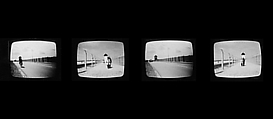Dachau 1974
Beryl Korot American
Not on view
Recognized since the early 1970s as a pioneer of video art and multi-channel works in particular, Beryl Korot creates video installations that explore the structural and conceptual links between weaving techniques and video editing. This groundbreaking work, which dates to the first decade of video’s emergence on the New York scene, represents the artist’s earliest multi-channel installation and the first to explore the relationship between "loom programming" and video art as methods of communication. In 1975 Korot told the SoHo Weekly News: "I started to weave and do video almost at the same time. As a weaver it has become increasingly important to work with video in a non-linear way. Weaving technology is a very old technology, and it’s involved with simple repetitions of thread that are pre-determined by the weaver. I developed this piece in the same way, using [the four video channels as] what I consider threads 1 and 3, and 2 and 4 to bind the work as it proceeds in time."
Dachau 1974 hauntingly documents the former Nazi concentration camp through black-and-white footage displayed on two sets of paired screens and a synchronized soundtrack recorded on location. Rhythmically edited sequences phase in and out of sync to move the viewer through the site. Too young to remember the Holocaust herself, the artist aimed to capture Dachau as it existed in the mid-1970s, once it had been transformed into a tourist site. Korot does not attempt to present the history of Dachau, but instead focuses on what remains: architectural ruins as relics of past horrors. "This is a fragile work," Korot explains. "In its verbal silence, rigorous formalism, and focus on the present, it ultimately depends upon human memory to endow it with meaning." Powerfully framing place and time, Dachau 1974 explores the role of images and mediating technologies in processing sites of trauma.
Korot edited each video channel according to the logic of a loom program. A framed pictographic notation exhibited alongside the videos serves as the "score" for the edited footage, revealing the artist’s image ordering system and the relationships created across the four channels. The result is a visual rather than story-driven narrative, one that is not linear or temporally unified, but that nonetheless registers the passage of time, just as textiles compress time by accumulating lines of woven yarn.
Due to rights restrictions, this image cannot be enlarged, viewed at full screen, or downloaded.
This artwork is meant to be viewed from right to left. Scroll left to view more.




